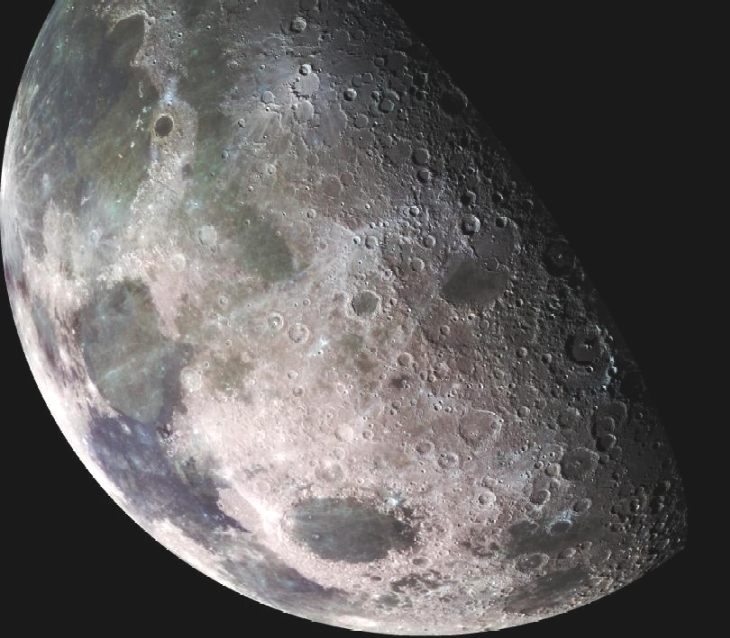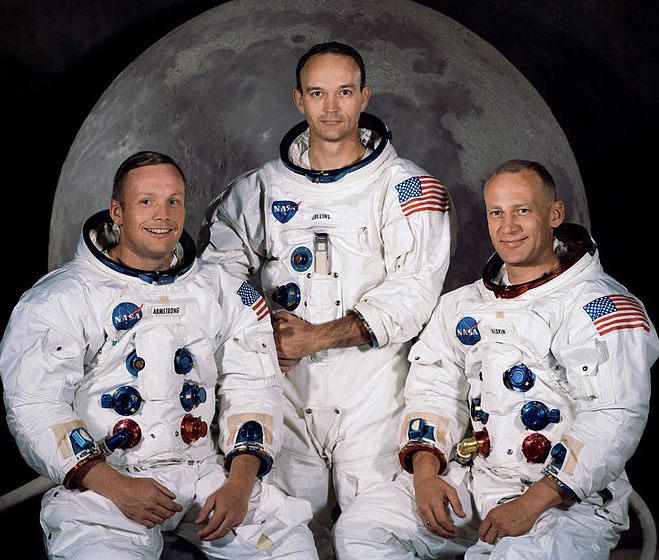|

The Moon is the only natural satellite of the Earth, and the fifth largest satellite in the Solar System. It is the largest natural satellite of a planet in the Solar System relative to the size of its
primary, having 27% the diameter and 60% the density of Earth, resulting in 1⁄81 its mass. The Moon is the second densest satellite after Io, a satellite of Jupiter.
The Moon is in synchronous rotation with Earth, always showing the same face with its near side marked by dark volcanic maria that fill between the bright ancient crustal highlands and the prominent impact craters. It is the brightest object in the sky after the Sun, although its surface is actually very dark, with a reflectance similar to that of coal. Its prominence in the sky and its regular cycle of phases have, since ancient times, made the Moon an important cultural influence on language, calendars, art and mythology. The Moon's gravitational influence produces the ocean tides and the minute lengthening of the day. The Moon's current orbital distance, about thirty times the diameter of the Earth, causes it to appear almost the same size in the sky as the Sun, allowing it to cover the Sun nearly precisely in total solar eclipses. This matching of apparent visual size is a coincidence. The Moon's linear distance from the Earth is currently increasing at a rate of 3.82±0.07cm per year, however this rate is not constant.
The Moon is thought to have formed nearly 4.5 billion years ago, not long after the Earth. Although there have been several hypotheses for its origin in the past, the current most widely accepted explanation is that the Moon formed from the debris left over after a giant impact between Earth and a Mars-sized body. The Moon is the only celestial body other than Earth on which humans have set foot. The Soviet Union's Luna programme was the first to reach the Moon with unmanned spacecraft in 1959; the United States' NASA Apollo program achieved the only manned missions to date, beginning with the first manned lunar orbiting mission by Apollo 8 in 1968, and six manned lunar landings between 1969 and 1972, with the first being Apollo 11. These missions returned over 380 kg of lunar rocks, which have been used to develop a geological understanding of the Moon's origins, the formation of its internal structure, and its subsequent history.
After the Apollo 17 mission in 1972, the Moon has been visited only by unmanned spacecraft, notably by the final Soviet Lunokhod rover. Since 2004, Japan, China, India, the United States, and the European Space Agency have each sent lunar orbiters. These spacecraft have contributed to confirming the discovery of lunar water ice in permanently shadowed craters at the poles and bound into the lunar regolith. Future manned missions to the Moon have been planned, including government as well as privately funded efforts. The Moon remains, under the Outer Space Treaty, free to all nations to explore for peaceful purposes.The Apollo program was the third human spaceflight program carried out by the National Aeronautics and Space Administration (NASA), the United States' civilian space agency. First conceived during the Presidency of Dwight D. Eisenhower as a three-man spacecraft to follow the one-man Project Mercury which put the first Americans in space, Apollo was later dedicated to President John F. Kennedy's national goal of "landing a man on the Moon and returning him safely to the Earth" by the end of the 1960s, which he proposed in a May 25, 1961 address to Congress. Project Mercury was followed by the two-man Project Gemini (1962–66). The first manned flight of Apollo was in 1968 and it succeeded in landing the first humans on Earth's Moon in 1969 through 1972.
American lunar exploration began with robotic missions aimed at developing understanding of the lunar surface for an eventual manned landing: the Jet Propulsion Laboratory's Surveyor program landed its first spacecraft four months after Luna 9. NASA's manned Apollo program was developed in parallel; after a series of unmanned and manned tests of the Apollo spacecraft in Earth orbit, and spurred on by a potential Soviet lunar flight, in 1968 Apollo 8 made the first crewed mission to lunar orbit. The subsequent landing of the first humans on the Moon in 1969 is seen by many as the culmination of the Space Race.
Neil Armstrong became the first person to walk on the Moon as the commander of the American mission Apollo 11 by first setting foot on the Moon at 02:56 UTC on 21 July 1969. The Apollo missions 11 to 17 (except Apollo 13, which aborted its planned lunar landing) returned 382 kg of lunar rock and soil in 2,196 separate samples. The American Moon landing and return was enabled by considerable technological advances in the early 1960s, in domains such as ablation chemistry, software engineering and atmospheric re-entry technology, and by highly competent management of the enormous technical undertaking.
Scientific instrument packages were installed on the lunar surface during all the Apollo landings. Long-lived instrument stations, including heat flow probes, seismometers, and magnetometers, were installed at the Apollo 12, 14, 15, 16, and 17 landing sites. Direct transmission of data to Earth concluded in late 1977 due to budgetary considerations, but as the stations' lunar laser ranging corner-cube retroreflector arrays are passive instruments, they are still being used. Ranging to the stations is routinely performed from Earth-based stations with an accuracy of a few centimetres, and data from this experiment are being used to place constraints on the size of the lunar core.

AVIATION
A - Z

Solarnavigator
is designed to carry the Scorpion
anti pirate weapon. A fleet of such autonomous vessels could be
the basis of an international peacekeeping, and/or emergency
rescue force. The
navigation system that is being developed for SolarNavigator
could have prevented the sinking of the Costa Concordia. This
might be of interest to fleet operators.
|


